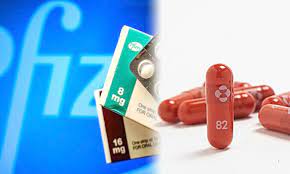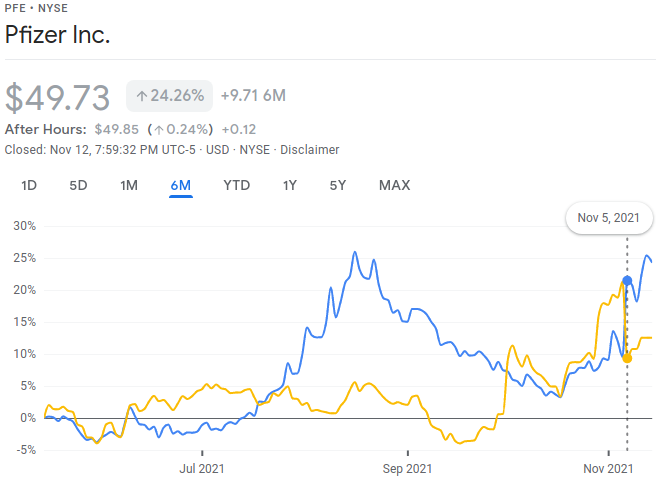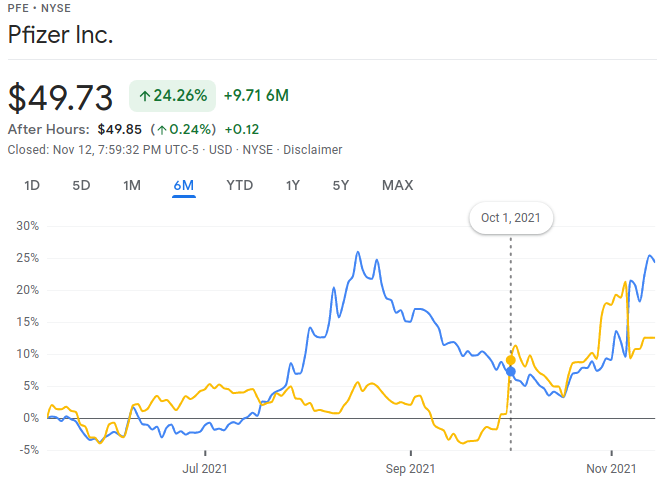A pharmaceutical stock pricing mystery
post by DirectedEvolution (AllAmericanBreakfast) · 2021-11-14T01:19:54.930Z · LW · GW · 2 commentsContents
2 comments
Epistemic status: case study based on a few hours' research. I own shares in a health sciences fund, but don't actively trade or own individual stocks in either of these companies. This is part of a larger project to understand the pharmaceutical industry, and isn't meant as investment advice.

Merck and Pfizer are two of the biggest pharmaceutical companies in the world. Each has been working on an antiviral pill for COVID-19. Merck's is called molnupiravir, and Pfizer's is Paxlovid; you can remember them by alliteration.

At 6:45 AM on Nov. 5th, Pfizer announced preliminary results of the phase III Paxlovid trial, showing that it has 89% efficacy. Their stock price jumped from $43.85 to $48.61. With 5.725 billion shares outstanding, that represents a $27 billion jump in their market cap.
Interestingly, that same day, Merck's stock price droped from $90.54 to $81.61, representing a $23 billion loss in market cap. Why?
Merck had already released preliminary results for molupiravir back on Oct. 1. Molnupiravir has an efficacy of 50%, while Paxlovid has 89% efficacy. So the market isn't just updating on the fact that Pfizer produced such a highly effective drug, but on the fact that that molnupiravir is second-rate.

Let's go back to Oct. 1. What did Merck and Pfizer's stock do that day?
Merck's jumped from $75.11 to $81.40, representing an increase in $16 billion in market cap. But this time, Pfizer's stock declined a mere 8 cents.
That's the mystery.
Let's assume that the market price for both Merck and Pfizer reflected the market's expectation for the absolute effectiveness of molnupiravir and Paxlovid and demand for the drug; and also thereby their relative effectiveness and market share.
If Merck's stock increase on Oct. 1 was due molnupiravir exceeding expectations for its effectiveness, then this should also have made the market increase its confidence that molnupiravir would turn out to be more effective than Paxlovid. This, therefore, should have translated into prediction that Merck would attain greater market share than previously predicted. And that should have translated into a decreased stock price for Pfizer. This is not what we see.
One explanation is that some factor unrelated to molnupiravir or Paxlovid cancelled out the expected negative effect of molnupiravir's approval on Pfizer's stock price almost precisely. Searching Google News for "Pfizer" on Oct. 1 doesn't turn up anything obvious, though.
Another is that the market substantially rewards the clarity and excitement of a drug approval. Perhaps Merck's drug had exactly the effectiveness that the market had expected, so that was already priced in. The $15 billion boost in their market cap represented the market's relief that the approval was done. They were afraid of some random regulatory snarl. But in that case, wouldn't the alleviation of that risk have also impacted Pfizer's stock price, since less risk for molnupiravir would have meant it had a greater chance of success against Paxlovid?
If this "clarity and excitement" theory is true, then it should be possible to profit off of similar cases. Moderna was already making tentative deals to market its product contingent on approval. Perhaps the savvy investor should consider base rates, read the tea leaves, note the contingent advance deals, and the fact that the trial wasn't prematurely terminated, and invest in advance.
A third possibility is that this is the limit of market efficiency. On Nov 5th, people were able to grasp that Pfizer's success meant Merck's failure, because you could line the two effectiveness figures up side by side (50% vs. 89%) and see that lo, one is much bigger than the other. But on Oct. 1, people just weren't making the comparison, since Pfizer's drug wasn't approved yet.
If we accept the rationale that a boost in molnupiravir's chances negatively impacted Paxlovid's chances, and vice versa, then the "market failure" on Oct. 1 would have presumably been a failure to negatively adjust Pfizer's stock in the wake of the molnupiravir announcement.
However, as we know with the benefit of hindsight, Pfizer ultimately was the winner in this competition. So not only would we have failed to profit if we'd somehow tried to "correct" for this apparent "irrationality" by, say, shorting Pfizer on Oct 1, but we'd have doubly failed when Pfizer's Paxlovid ultimately proved to be better than molnupiravir on Nov. 5.
A fourth explanation is that Merck's 50% effectiveness result on Oct. 1 updated the market on two points:
- A treatment in this class was going to be more profitable and easier to make than the market originally thought. This increases the price of both Merck and Pfizer.
- Merck seemed more likely than before to beat Pfizer. This increases the price of Merck and decreases the price of Pfizer.
If the first factor cancels out the second factor for Pfizer, we'd obtain the result of no motion in the stock price.
One of the recurrent themes in investigating the pharmaceutical industry is that you have to consider context. For a given disease or drug target, there will often be more than one company racing toward a treatment. There might even be multiple similar classes of drugs, all in the middle of trials at the same time.
Understanding what fraction of the company's value is tied up in the drug, and how much competition it faces from a wide range of alternative drugs, is key to interpreting price changes and business decisions. When you learn about a drug, your first thought should be "who else is making something similar, what are the current treatments for this condition, and what's the historical track record for this disease/drug target/drug class?"
This may not give you an edge in trading, but it might at least help this big, confusing space make a little more sense.
2 comments
Comments sorted by top scores.
comment by PeterMcCluskey · 2021-11-14T03:21:17.335Z · LW(p) · GW(p)
If Merck’s stock increase on Oct. 1 was due molnupiravir exceeding expectations for its effectiveness,
That doesn't seem quite right. I'll guess that the news was near the middle of the expected range, and the stock rose because of the increased chances of FDA approval, while not causing much change in expected effectiveness conditional on FDA approval.
Replies from: AllAmericanBreakfast↑ comment by DirectedEvolution (AllAmericanBreakfast) · 2021-11-14T04:13:03.147Z · LW(p) · GW(p)
I actually came up with one more explanation, which is added to the main body of the post but reproduced here for your convenience:
A fourth explanation is that Merck's 50% effectiveness result on Oct. 1 updated the market on two points:
- A treatment in this class was going to be more profitable and easier to make than the market originally thought. This increases the price of both Merck and Pfizer.
- Merck seemed more likely than before to beat Pfizer. This increases the price of Merck and decreases the price of Pfizer.
If the first factor cancels out the second factor for Pfizer, we'd obtain the result of no motion in the stock price.